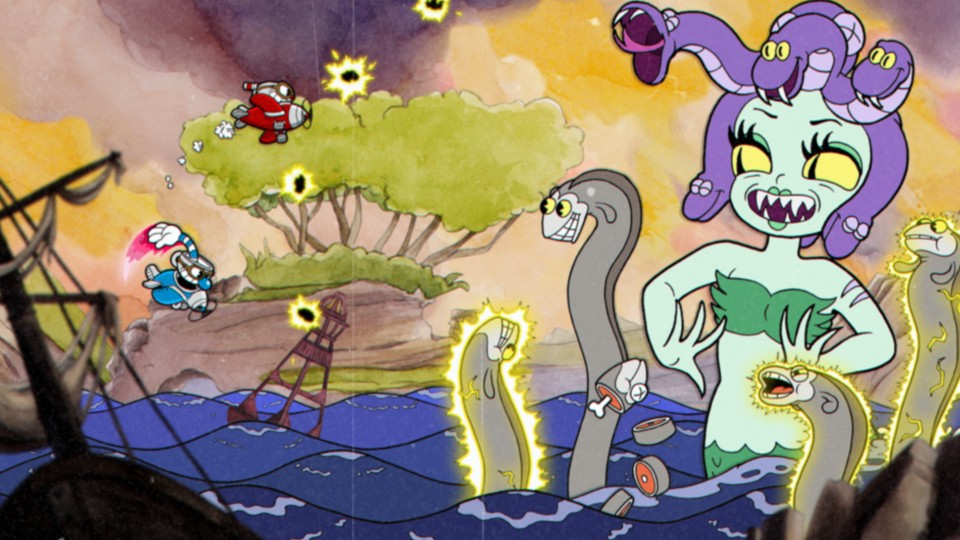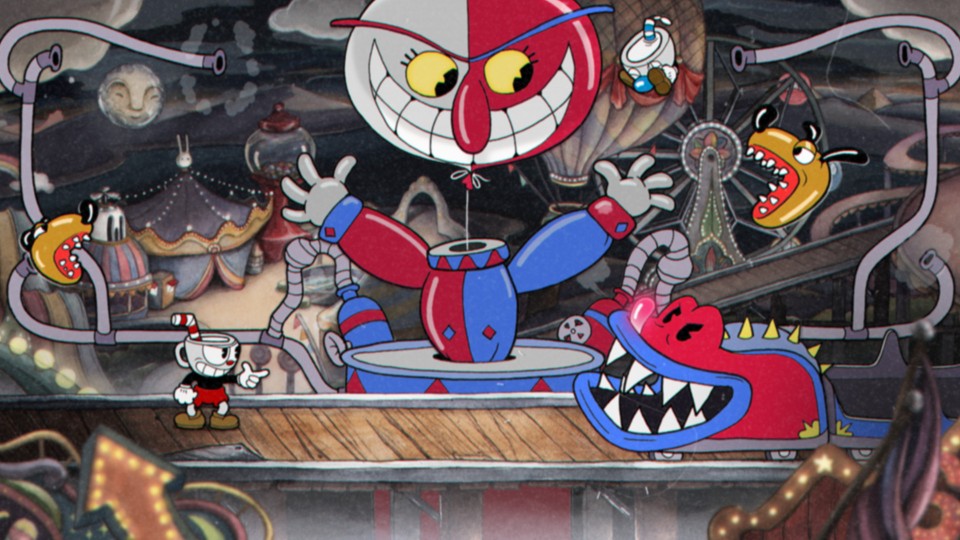Graphics have come a long way in the last 30 years. Gamers had to rely solely on their imagination back in the days of text adventures. Single pixels became the heroes in multiple adventures during the early 80s. By the 90s, characters started to show more detail, but gamers wanted more. For decades, developers have pushed consoles to their limits to try and mimic the quality seen in movies, TV shows, and cartoons.
Don Bluth came the closest with Dragon’s Lair and Space Ace on arcade in 1983. Despite destroying everything else when it came to art style, the gameplay was shallow, and was more akin to small cartoons playing after every button press. It’s strange then, that in the age of HD graphics and a drive for realism, we’ve never truly had a playable cartoon; until now.
Cuphead is, in essence, a bullet-hell game designed round a 1930’s cartoon aesthetic. You, and a friend (if you want to go co-op), control Cuphead and Mugman. The two brothers lost a bet against the devil, and in doing so lost their souls. The devil suggests that if they can bring him the contracts of all the others in Inkwell Isle that have lost their souls, they may just go free. There are 17 contracts to collect, and each is obtained by taking on its owner in what can only be described as infuriating – but enjoyable – boss fights.
In fact, Cuphead is essentially Boss Fight: The Game. Each stage only takes two to four minutes to complete, but it’s not uncommon to spend 15-to-30 minutes on each. The stage begins, you’re introduced to your opponent, and then all (bullet) hell breaks loose. Each opponent has a number of phases they go through as they lose HP, they each get increasingly more difficult.By default, Cuphead only has three hit points; take damage in the opening phase and you might as well restart and try again.

While the idea of playing a three minute round 15 times sounds like a chore, a death screen usually means you misread a cue, mistimed a jump, or you entered a new phase and are just learning the ropes. It rarely feels like you’re losing over and over again out of punishment, and every attempt will take you closer to the end of the stage. Occasionally (although quite often in a specific stage with a roller-coaster) an enemy’s attack might coincide with a random stage event in a way that means there’s no way to avoid damage. With Cuphead only being able to take three hits before death, and no way to regain health mid-level, these events can ruin a perfect run through a stage. You will die a lot in every stage of Cuphead, but it’s only these deaths that cause frustration.
There’s a seesaw of emotions when playing. Elation kicks in when “Knockout” flashes across the screen at the end of a stage, and it disappears almost as quickly as you move Cuphead to the next part of the world map. It’s intimidating knowing that you’ll be dying a lot, and that there’s no way to know how long the next level is going to take. The few times there’s a break from the boss fights is to take on the equally difficult side-scrolling run-and-gun areas.
These play a little more like the bullet-hell games you might know. You move from left to right, avoiding projectiles and shooting enemies. The only difference here is that you’ve got the added difficulty of it being a platformer. You’ll die on these stages as well, and a perfect run-through clocks in at a couple minutes.
Thankfully there are upgrades that can make the experience a little easier. Coins collected as you progress can be spent on buying new bullets (they all come from Cuphead and Mugman’s finger guns) and super moves can be unlocked during bonus stages. Every successful hit or parry increases your super gauge which consists of 5 playing cards. Hit the special button before all 5 are showing and you’ll deplete one with a mid-level attack.

Use all five at once and you’ll trigger the super you have equipped. This will mean a valuable few seconds of invulnerability or a giant move that’ll help knock the enemy into their next phase. How you use your special gauge, and when you swap between the bullets Cuphead has equipped, means huge things for how you progress. Cuphead isn’t interested in beating you down mercilessly; it’s interested in making you better at the game.
But you’ve seen the screenshots dotted through this review, and yes, it looks as good in motion, if not better. StudioMDHR created all of their art using the same techniques the old masters of animation used 100 years ago. Cells were created and painted by hand, and with the grainy post-effects and colour bleeding they’ve placed on top, Cuphead becomes one of the most authentic cartoon videogames ever created.
There’s no part of Cuphead that doesn’t ooze charm and style, and Porkrind’s voice (the owner of Porkrind’s Emporium) helps push you deeper into believing that maybe – just maybe – this game was somehow developed in the 1930s. It’s just a shame that the story is told in static frames instead of being fully animated.

Going in, there was a real fear that Cuphead was going to be style over substance. You’ll likely feel the same as you punish yourself over and over through the first few stages. That feeling disappears once you start reading the enemies’ tells, and get a good understanding of when specials should be used. Eventually you come to understand what you’re about to partake in, and in the moments of quiet as the enemy gets knocked into its next phase, you’ll stare at the backgrounds, or the over the top animations, and you’ll wonder why a game like this hasn’t been made before.
A good bullet-hell game doesn’t need amazing graphics to hook you into its gameplay, but it’s certainly nice to have one that makes every frame look gorgeously unique.